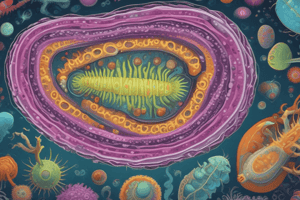Podcast
Questions and Answers
What is Archaeplastida?
What is Archaeplastida?
- A group of single-celled organisms with a feeding groove
- A monophyletic group that includes kingdom fungi and kingdom animalia
- A superkingdom of eukaryotes with amoeba-like cells
- One of the five supergroups of eukaryotes including red algae, green algae, and land plants (correct)
What does Amoebozoa refer to?
What does Amoebozoa refer to?
A superkingdom of eukaryotes with amoeba-like cells.
What characterizes the Chromalveolata supergroup?
What characterizes the Chromalveolata supergroup?
It may have originated from secondary endosymbiosis and includes the alveolates and stramenopiles.
Define Excavata.
Define Excavata.
What does Opisthokonta include?
What does Opisthokonta include?
What are Rhizaria?
What are Rhizaria?
Explain the role of pseudopodia.
Explain the role of pseudopodia.
What do the flagella do?
What do the flagella do?
What is the function of cilia?
What is the function of cilia?
What does the term 'alteration of generations' mean in the context of protists?
What does the term 'alteration of generations' mean in the context of protists?
Flashcards are hidden until you start studying
Study Notes
Supergroups of Protists
- Archaeplastida: Includes red algae, green algae, and land plants; originated from an endosymbiotic relationship between heterotrophic protists and cyanobacteria.
- Amoebozoa: Comprises eukaryotes with amoeba-like cells characterized by movement and feeding through pseudopodia.
- Chromalveolata: Proposed supergroup containing alveolates and stramenopiles, likely arising from secondary endosymbiosis; notable for membrane-enclosed sacs (alveoli).
- Excavata: Contains flagellated, asymmetrical organisms with a distinct feeding groove; includes diplomonads and euglenozoans.
- Opisthokonta: Monophyletic group encompassing choanoflagellates, fungi, and animals; features a single apical flagellum with a contractile collar.
- Rhizaria: Notable for foraminifera with porous shells housing harbored photosynthetic algae; includes radiolarians with intricate glassy silica exteriors.
Key Features and Examples
- Pseudopodia: Cellular extensions used for movement and feeding in amoeboid cells.
- Flagella: Whiplike structures aiding movement in single-celled organisms.
- Cilia: Hairlike projections enhancing locomotion, different from flagella.
- Alteration of Generations: Protists undergo complex sexual life cycles alternating between diploid and haploid phases.
Specific Organisms and Functions
- Diplomonads (Excavata): Possess mitosomes, two identical nuclei, and multiple flagella.
- Euglenozoans (Excavata): Utilize two long flagella for movement; contain an eyespot for light sensing.
- Giardia lamblia: Waterborne protist causing severe diarrhea.
- Trypanosoma brucei: Kinetoplastid responsible for African sleeping sickness.
- Green Algae (Archaeplastida): Share chloroplast features with land plants; two main types are chlorophytes and charophytes.
- Red Algae (Archaeplastida): Primarily multicellular, lack flagella, vary in size and complexity.
- Stramenopiles (Chromalveolata): Include diatoms and brown algae; characterized by textured flagella.
- Slime Molds (Amoebozoa): Categorized into plasmodial and cellular based on their life cycles.
Functional Roles in the Environment
- Foraminifera utilize pseudopodia for trapping and engulfing food.
- Radiolarians employ needle-like pseudopods for capturing food particles.
- Green algae and red algae contribute to aquatic ecosystems and serve as primary producers.
Studying That Suits You
Use AI to generate personalized quizzes and flashcards to suit your learning preferences.




